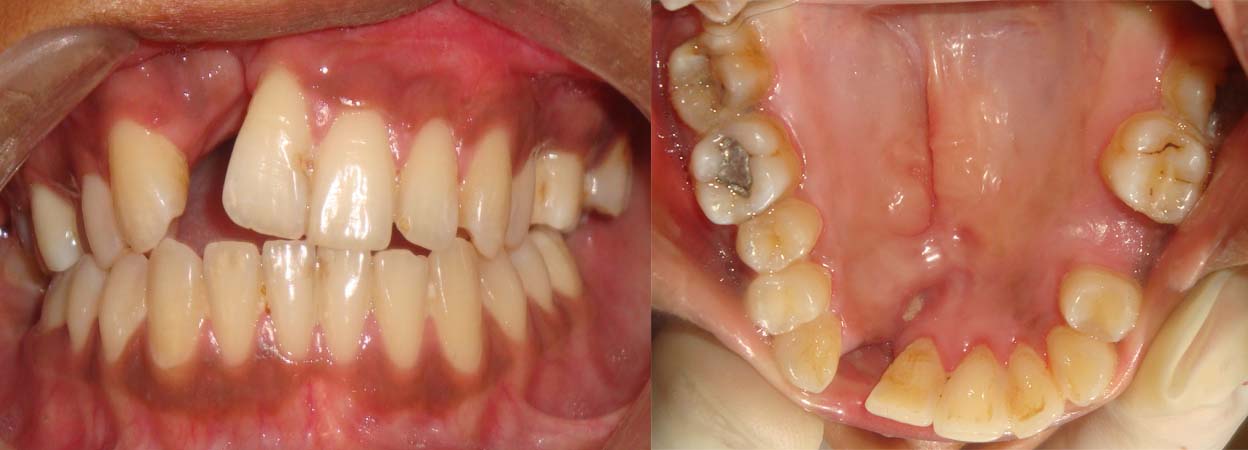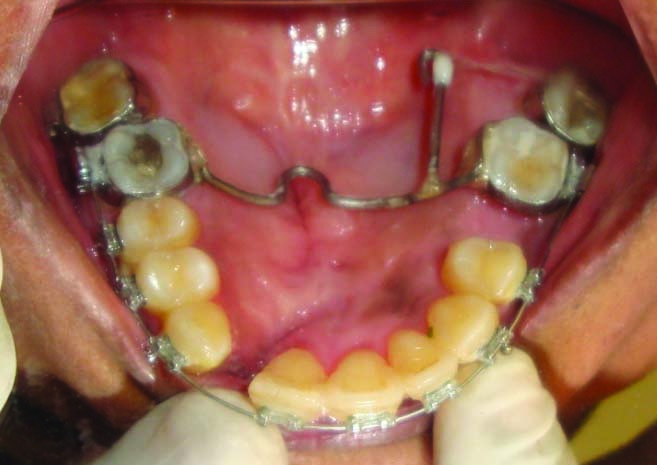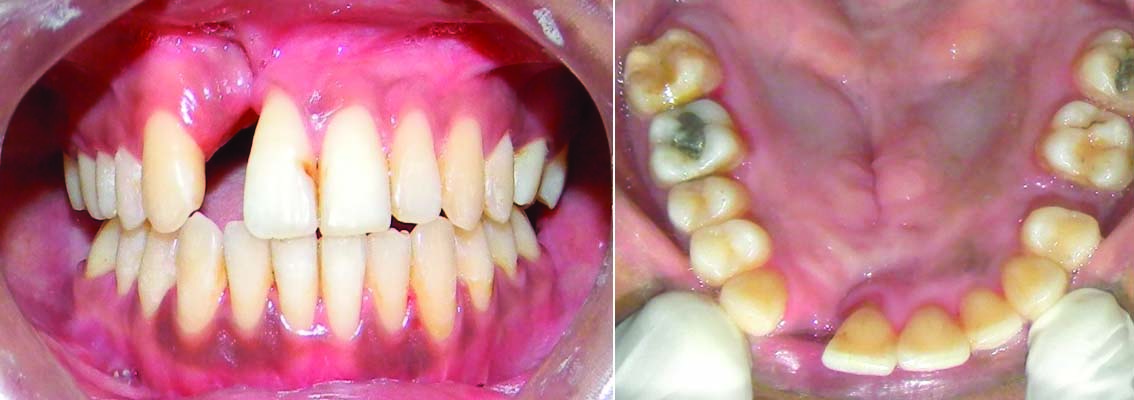Clinician Corner- A Simple and Efficient Modified Goshgarian Arch (“T” Arch) Appliance for Correcting Single Tooth Scissor Bite
Vikram Rajendra Pagar Patil1, N G Toshniwal2, Sayali Vikram Pagar Patil3, Pawankumar Dnyandeo Tekale4, Harshal Ashok Patil5
1 Senior Lecturer, Department of Orthodontics, S.M.B.T. Dental College and Hospital, Sangamner, Maharashtra, India.
2 Professor and Head, Department of Orthodontics, Rural, Dental College and Hospital, Loni, Maharashtra, India.
3 Senior Lecturer, Department of Periodontics, SMBT Dental College Sangamner, Maharashtra, India.
4 Senior Lecturer, Department of Orthodontics, Dr Rajesh Ramdasji Kambe Dental College and Hospital, Akola, Maharashtra, India.
5 Practitioner, Department of Orthodontics, Aditya Chambers, Housing Society, Jalgaon, Maharashtra, India.
NAME, ADDRESS, E-MAIL ID OF THE CORRESPONDING AUTHOR: Dr. Harshal Ashok Patil, Private Orthodontic Practice, Aditya Chambers, Housing Society, Jalgaon-425001, Maharashtra, India.
E-mail: drharshalortho@gmail.com
Scissor bite is a rare form of malocclusion that is often accompanied by varying degrees of facial asymmetry. Correction and treatment of scissor bite in posterior teeth is a challenging job for an orthodontist. There are several treatment options for correction of scissor bite in posterior teeth but some have their own ill-effects on the dentition thus contributing further to the problem and some require patient compliance which compromises the outcome of the treatment. Therefore to overcome these drawbacks we have designed a new appliance to correct the molar scissor bite.
Case Report
A 26-year-old male reported with the chief complaint of irregularly placed upper front teeth and difficulty in chewing from the left side of the mouth. The patient had history of operated cleft lip and palate at age of 10 years. The clinical examination revealed skeletal Class I base with orthognathic maxilla and mandible, scissor bite in relation to maxillary second molar on left side, missing maxillary right lateral incisor and maxillary left second pre-molar [Table/Fig-1].
Pre-treatment intra oral photographs.

Appliance fabrication:
A double buccal tube with a headgear tube was used on the maxillary first molar bands and the bands were then taken in an impression, and a working plaster cast was made. T-Arch was made of 18 gauge stainless steel. This wire was bent in the form of Goshgarian arch and adapted along the palatal curvature. It was then soldered on the first molar bands, taken in the impression.
Another hook arm of the same wire was made extending approximately 4-6 mm from the free gingival margin on the palatal side. This arm was soldered to the Goshgarian arch with the arm extending till the central fossa of the second molar. This arm is approximately 2 mm away from palatal tissues making this assembly an atraumatic appliance and there is minimal occlusal interference.
Appliance Placement and Treatment Plan:
A 0.022-in pre-adjusted edgewise appliance was placed with 0.016’’ NiTi wire in the maxillary arch for 4 weeks for initial alignment.
Once maxillary teeth were aligned, posterior bite block was given on the opposite side on the molar and the appliance was cemented.
The hook soldered to the “T” arch was used for engaging an E-chains crossing over the occlusal surface of the maxillary second molar which was in scissor bite. This helps to concentrate the forces on maxillary second molar only. The 50-60 gm of force was achieved by adjusting the length of E-chain [Table/Fig-2].
Intra oral photographs with appliance placement, the modification is shown with arrow.

A lingual button, a Begg bracket or other bracket was bonded to the lingual surface of the maxillary second molar in scissor bite in order to avoid slippage of the E-chain on the proximal side of the tooth or else it might lead to gingival trauma [Table/Fig-2]. E-chain has to be changed every 15 days till scissor bite get corrected, hereby making it a completely non-compliant appliance which adds to the outcome of the treatment.
When the scissor bite with maxillary second molar was corrected, with the sequential wire change as 0.017”-0.025” NiTi followed by 0.019”-0.025” SS wire, the case was finished with optimal overjet and overbite.
Discussion
A scissor bite is simply defined as buccal displacement of a maxillary posterior tooth, with or without contact between the maxillary lingual cusp and the mandibular antagonist’s buccal cusp [1,2]. Many determinations have been made to correct scissors-bite and establish proper molar interdigitating for prosthetic or orthodontic treatment. Conventional treatment mechanics cannot offer a solution to correct severe transverse discrepancies, especially in adult patients, due to their limitations. Subsequently, patients with a severe scissors-bite are sometimes managed with surgical orthodontic correction [1], using mini-screw for mandibular posterior scissor bite correction [2], nonsurgical options for correcting a simple posterior scissors-bite, including edgewise appliances [3], transpalatal arch appliances with intramaxillary elastics [4,5], lingual arch appliances with intramaxillary elastics [6], Uprighting second molars with micro-implant anchorage [7], Scissors-bite correction on second molar with a dragon helix appliance [8]. The perilous dealings for scissors-bite correction are intruding and palatally tipping the involved tooth when it is both extruded and buccally flared, but it creates problems such as repetitive bonding failure and loss of anchorage.
Elastics have also been used by some orthodontist to correct the scissor bite in second molar region. It has proved to be an effective treatment in mild scissor bite cases. The main drawback of this type of treatment is patient compliance i.e., patient has to use the given elastics regularly. Thus patient compliance becomes an important factor for the success of the treatment. Considering the problems faced in correction of posterior crossbite in maxillary second molar region we have successfully designed a new non-compliant appliance. This clinical report describes an innovative design, a modified Goshgarian arch (“T” arch) which is used to apply isolated forces on maxillary second molars with the anchorage obtained by “T” arch. This appliance provides effective tooth movement and the convenience of a simple and small design.
Point of application of force is a very important factor in orthodontic correction of scissor bite. In this case there is a palatally directed force from the E-chain which is exerted on the palatal root of the molar in scissor bite. For palatal tipping of the molar 50-60 grams of force was applied [5,6]. In the present case, no root resorption was seen.
A posterior bite block was given on the opposite side on the molar so as to raise the bite so that enough space could be given to the molar in scissor bite to travel in its desired position. Adequate alignment of maxillary second molars in crossbite can be achieved within 2-3 months [Table/Fig-3].
Post-treatment photographs after correction of scissor-bite correction.

After correcting scissor bite with respect to the second molars, it can now be incorporated into a continuous archwire with other teeth. It will help in the prevention of relapse of the crossbite correction. Oral hygiene maintenance is important during the treatment phase in order to prevent other complications.
Advantages
This assembly can be used bilaterally for the correction of bilateral scissor bite in maxillary arch.
This appliance is fabricated using 18 gauge wire, which increases the rigidity of the appliance.
Goshgarian arch with the modified arm can be moved gingivally to intrude the molar and can be moved occlusally to extrude the molar in scissor bite.
It is completely non-compliant appliance which adds to the outcome of the treatment.
Limitation
This appliance cannot be used in correction of single tooth scissor bite in mandible, due to bulkiness of the appliance and interference with tongue
Conclusion
The modified Goshgarian arch (“T” arch) is a simple and effective intervention to correct the second molar in scissor bite. The advantage of this appliance is cost effectiveness reduced chair side time and patient comfort. Most importantly it is a non-compliant appliance and does not have any ill-effects on the dentition.
[1]. Inada E, Saitoh I, Ishitani N, Iwase Y, Yamasaki Y, Normalization of masticatory function of a scissors-bite child with primary dentition: a case report Cranio 2008 26:150-56. [Google Scholar]
[2]. Tekale PD, Vakil KK, Vakil JK, A novel approach for the correction of unilateral scissor bite using micro-implants J Indian Orthod Soc 2016 50:59-60. [Google Scholar]
[3]. Ramsay DS, Wallen TR, Bloomquist DS, Case report MM. Surgical-orthodontic correction of bilateral buccal crossbite (Brodie syndrome) Angle Orthod 1990 60:305-11. [Google Scholar]
[4]. Kucher G, Weiland FJ, Goal-oriented positioning of upper second molars using the palatal intrusion technique Am J Orthod Dentofacial Orthop 1996 110:466-68. [Google Scholar]
[5]. Nakamura S, Miyajima K, Nagahara K, Yokoi Y, Correction of single-tooth crossbite J Clin Orthod 1995 29:257-62. [Google Scholar]
[6]. Lim KF, Correction of posterior single-tooth crossbite J Clin Orthod 1996 30:276 [Google Scholar]
[7]. Park HS, Kwon OW, Sung JH, Uprighting second molars with micro-implant anchorage J Clin Orthod 2004 38:100-03. [Google Scholar]
[8]. Yun SW, Lim WH, Chong DR, Chung DR, Scissors-bite correction on second molar with a dragon helix appliance Am J Orthod Dentofacial Orthop 2007 132:842-47. [Google Scholar]